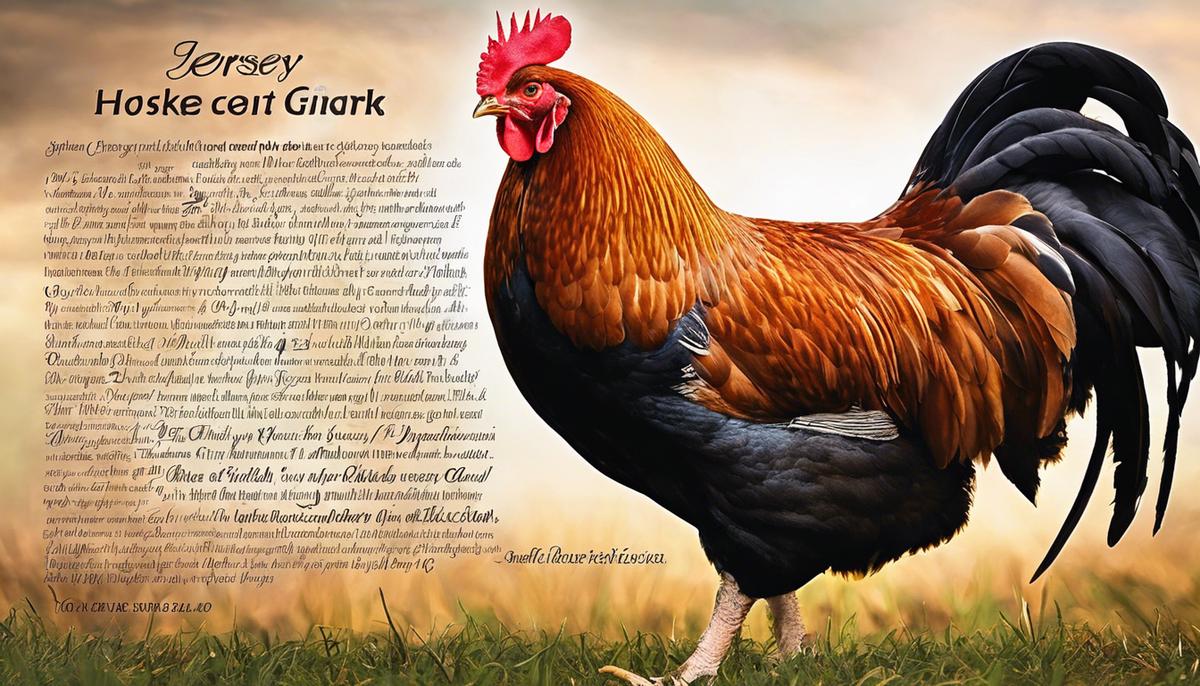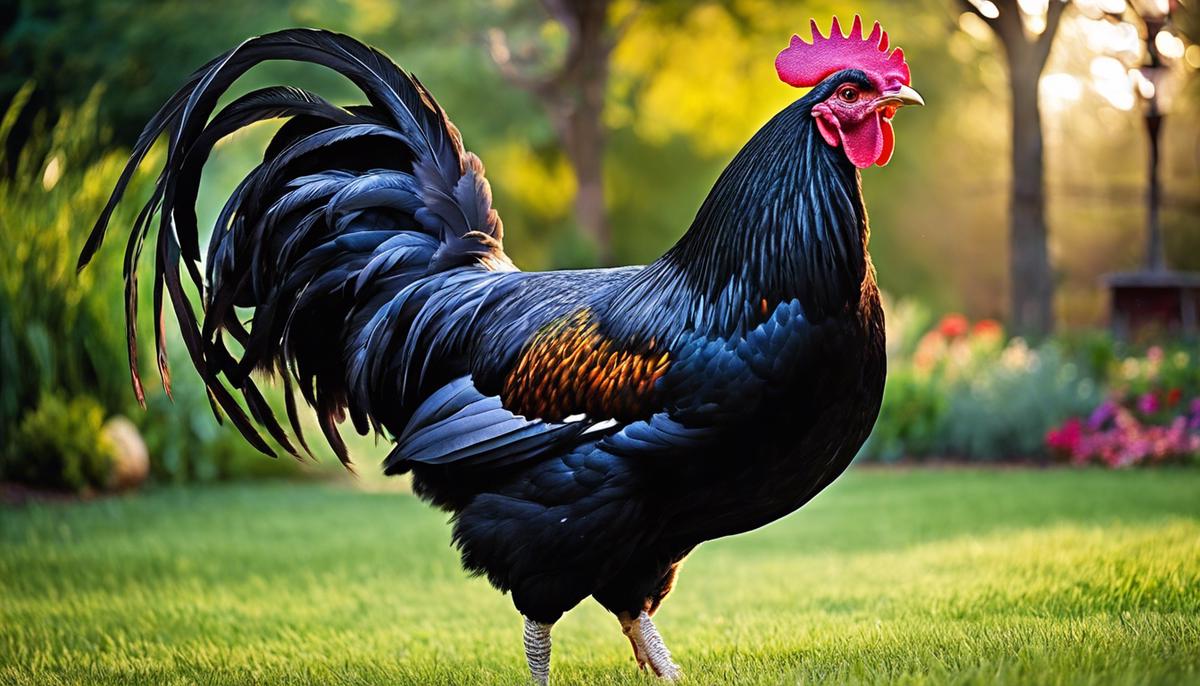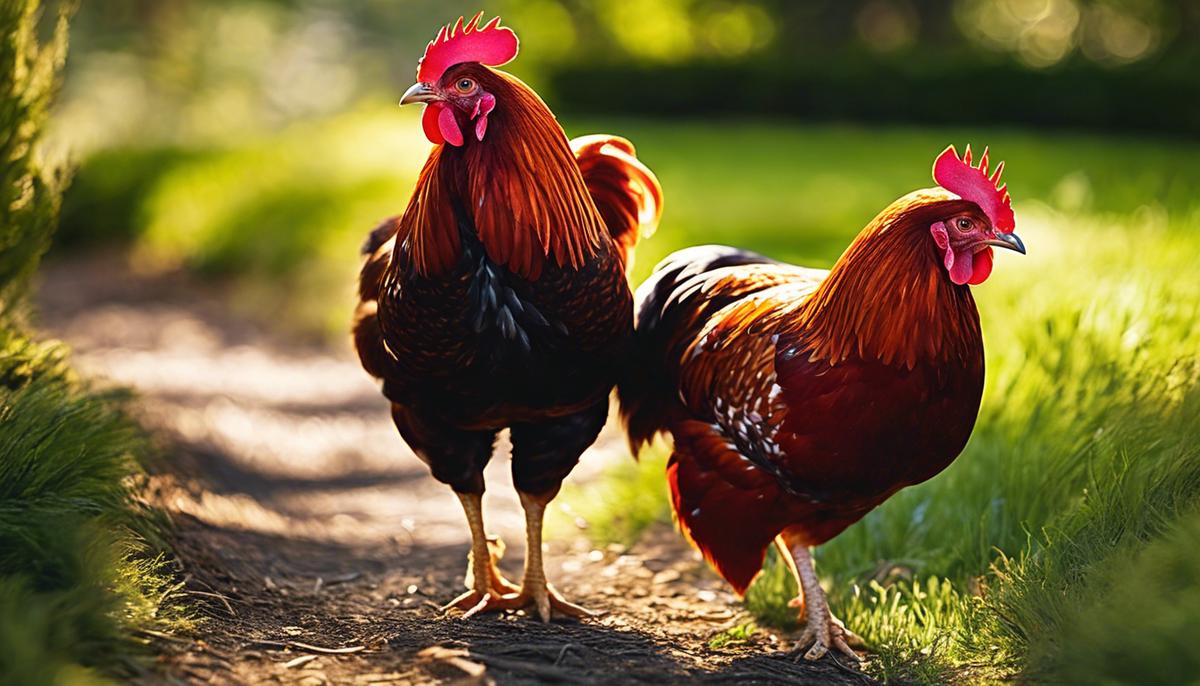

Agridisk
Egypt - Alexandria

All about jersey giant chicken, breeds , egg production
Description: Delving into the world of poultry, few breeds command as much attention as the Jersey Giant chicken. With its rich history, distinct characteristics, and robust production capacities, this breed offers a unique blend of utility and aesthetic appeal. This exploration covers its origins, the contributors to its development, and milestones in its breed history, while critically examining its physical attributes and behavioral traits. We'll move further into the best practices for caring and management to ensure their optimal growth and productivity. Finally, we turn to their primary merits- egg and meat production, providing a thorough understanding of the yield and quality that one can expect from raising these striking birds. Jersey Giants, the name says it all! These are no ordinary chickens but oversized domesticated birds known for their impressive size and mellow personality. Although fairly recent in the grand scheme of bird history, their history and unique breed specifications make them stand out in the larger poultry world. The origins of Jersey Giants can be traced back to the late 19th century. They were created in Burlington County, New Jersey, by brothers Thomas and John Black with one straightforward aim: to develop a breed that rivaled the size of turkey meat. The idea was to offer an alternative to turkey during the holiday season. Interesting, isn't it? Not an overnight creation, the hatching of these giants involved several other bird breeds. The exact mix remains a trade secret to this day, enticing enthusiasts and bird lovers alike. However, it's known that the Blacks used Dark Brahmas, Black Javas, and Black Langshans to some degree. This resulted in the making of the largest chicken breed worldwide, taking around six to eight years of selective breeding before they realized the desired traits. Jersey Giants really live up to their name, boasting mature weights of about 10-13 lbs for hens and 13-15 lbs for cocks. This massive size, perceived as an advantage initially, soon became a roadblock. Rapid growth rate of competing commercial breeds like the White Leghorn surpassed the production capabilities of Jersey Giants - remember, good things take time. Nonetheless, their size isn't their only attraction. They offer an array of praiseworthy characteristics. They possess a single comb and come in three recognized color variations: black, white, and blue. Jersey Giants stand out with their friendly temperament, being surprisingly gentle and easy to handle, contrary to what one might expect from a bird of this size! Dishing out delicious brown eggs, these giants have a moderate rate of egg production, laying around 150-200 eggs per year. Their meat is renowned for quality and flavor, with a relatively higher dressing percentage - that part of the bird which remains after removing inedible parts. However, the longer grow-out period often pushes Jersey Giants to the backyard, rather than the commercial industry, still considered an excellent choice for homesteading. A cautionary note: Due to their massive size, they are voracious eaters and require an adequate feed to meet their dietary needs. Overall, nickname them “the gentle giants,” Jersey Giants are certainly an unforgettable breed. Their colossal size, combined with a serene personality, makes them quite an enjoyable addition to backyards and hobby farms alike. The saga of these giants, from the aim of replacing turkeys to becoming a favorite amongst hobbyists, is a testament to their uniqueness. Despite facing stiff competition, these giants hold their ground firmly, stealing hearts one peck at a time! Diving deeper into the world of Jersey Giants, while the basics of this hefty, friendly breed is established, there still exists intriguing characteristics worth exploring. Let's embark on a journey to further investigate physical features and behavioral traits, emphasizing not just the breed's exterior, but also the undercurrents that make them a true standout. Upon first look, the giant in Jersey Giants isn't a misnomer. Standing around 2 feet tall, they make a sizable impression! Weighing up to 13 to 15 pounds for roosters and 9 to 10 pounds for hens, they exhibit strength and endurance. They boast a broad back and deep body, conveying a profound sense of power. The color variations seen in Jersey Giants are not just mere aesthetics but play a role in determining their health. Their plumage, predominantly black, blue, or white, is lustrous and dense, providing excellent defense in colder climates. A black variety with a green sheen and fine white feathers is a sight to behold! A fascinating note—their coat color is linked to their inner health, with richer, well-maintained coats indicative of healthier birds. Featuring a straight and moderately long back, their bodies provide plenty of space for well-developed muscles. The cushiony breasts confirm their meaty aspect. Their legs, too, deserve a mention. They are widely spaced, sturdy, and large, corroborating to their weighty nature. These legs are a clear signature trait, solid black or willow in color, depending on the variant. Jersey Giants, however, are more than just their impressive physical traits. Their behavior and temperament play as much of a role, if not more, in determining their desirability. Known to be calm, docile, and friendly, they depict a demeanor that can be a pleasant surprise given their grand size. This agreeable temperament enhances their charm, making them a viable option even for families with children. Moreover, they are adaptable, handling both confinement and free-ranging equally well, thanks to their hardy nature and even temperament. However, their ability to forage is not high, which may require a more attentive feeding routine. Though they are not designed for flight, these giants display remarkable determination and adaptability in searching food. The meat quality and egg production of Jersey Giants are not the only factors that make the breed commercially appealing. Beyond being a sustainable source of meat and eggs, they serve as excellent show birds and useful pets, given their attractive demeanors and hardy nature. Understanding the physical features and behavioral traits of Jersey Giants paints a vivid picture of their potentials. So whether they're gracing your backyard or just a notion you're entertaining, their unique charm radiates irrevocably. When enthusiastic hobbyists throw light on these magnificent birds, one can only marvel at the treasures housed under those impressive, glossy feathers. Renowned for their colossal size, Jersey Giants certainly live up to their name. As a chicken enthusiast, getting the best out of these gentle giants need proper care and management. A defining feature of Jersey Giants is their sturdiness. This breed is robust and hardy, capable of withstanding a variety of climates. This is great news for seasoned hobbyists and beginner backyard homesteaders alike. These birds are intimately less prone to common poultry diseases due to their size and strength. However, it’s always prudent to set up routine health checks for any signs of health issues. That said, their resistance to disease doesn't excuse lack of proper hygiene. Housing for Jersey Giants should be spacious and regularly cleaned. A clean coop not only minimizes the risk of disease, but also promotes smoother laying and a happier, stress-free environment for these birds. Because of their weight, Jersey Giants are not avid fliers. Still, they require sufficient room to roam about and forage, an activity that they take to with gusto. An ideal pen would include both covered spaces for protection from weather and open spaces for recreation and exercise. Progressing on their eating habits, these chickens do very well on a free-range diet, as they are great foragers. Supplementing this with high-quality chicken feed ensures balanced nutrition. Fresh water availability around the clock is equally crucial. Given their larger size, Jersey Giants consume more water than most chicken breeds. Although Jersey Giants are generally congenial, introducing new birds to an established flock can be pretty delicate. Quarantine the newcomers first, allowing them to gradually get used to the pecking order. This settling-in phase is also an opportunity to inspect new birds for potential health issues before they join the rest. In terms of handling, despite their size, Jersey Giants are markedly docile. However, care should be taken when lifting them due to their weight. Regularly spending time with them promotes bonding, and handling becomes more comfortable as they grow familiar with the keeper. Hatching eggs from Jersey Giants may present a more extended waiting game compared to other breeds, often taking one or two days longer. Keeping the incubator conditions stable throughout the waiting period is fundamental for successful hatching. Remember, hatchlings require special chick feed and a safe, warm environment, separated from the rest of the flock until they are old enough to join. Jersey Giants exhibit mild broodiness. If a hen begins to brood but you'd rather gather the eggs without incubating, consider employing a broody coop. This separate coop allows time for the brooding behavior to pass without putting any precious eggs at risk. In conclusion, Jersey Giants necessitate a tad more space and dietary consideration due to their large size, but the overall maintenance is comparable to that of other chickens. Their undeniable allure, high-quality meat, and friendly demeanor make these giants an excellent addition to any backyard, farm, or homestead. Now, let's take a closer look at the exceptional egg and meat production of the Jersey Giants. Known for its bountiful supply, these large chickens indeed provide an impressive amount of both eggs and meat. Speaking in terms of egg production, an average hen can lay anywhere between 150-200 eggs per year – that’s roughly 3 eggs a week! This might not shake the world of prolific layers like the White Leghorn, but considering their size and longevity, Jersey Giants prove to be consistent egg layers, especially during winter, which is a fantastic bonus for any backyard farmer. The eggs themselves are extra-large, with a beautiful brown shell. Jersey Giant eggs are not just large, they’re delicious as well! Many hobbyist farmers rave about their rich and creamy taste - a perfect addition to your breakfast menu. Shifting gears to meat production, the monumental size of Jersey Giants is clearly a hint towards their meat production prowess. These chickens offer an impressive yield. Dressing out at 70% of their live weight, these birds provide a hefty amount of meat. The meat from Jersey Giants is known for its richness and deep flavour, with many comparing it to the taste of heritage turkey. However, this breed of chicken does require a little patience. The Jerseys are slow growers, taking up to 6 months to reach their full size, whereas commercial chickens like the Cornish Cross can be ready for the table as early as 8 weeks. This slower growth rate might seem like a downside, but it actually ensures the development of strong skeletal structure and healthier birds. Another thing to realize is that Jersey Giants are not very efficient converters of feed to meat. Due to their size, they eat a significant quantity of feed, making them a bit more costly to raise for meat production alone. Yet, this is balanced out by their long productive lifespan, consistent egg production and their massive meat yield. When all is said and done, Jersey Giants are a dual-purpose breed with a balance skewed towards meat production. However, their competitive egg-laying ability, coupled with their friendly temperament and hardiness, makes them an excellent choice for hobby flocks. Whether it’s for the eggs, the meat, or simply their imposing yet friendly presence, Jersey Giants are definitely a breed worth considering in your poultry venture. It's evident that raising Jersey Giant Chickens demands a high level of care, but it also brings considerable rewards in return. The sheer size and the quality and extent of the meat and eggs they produce can make it worth your while. Their unique history and characteristics make them a fascinating breed to understand and rear, with the bonus they cater to a wide range of poultry needs- from egg-laying to meat production. This comprehensive guide underscores the breed's towering stature in the world of poultry and will hopefully be a useful tool in your journey of rearing these wonderful creatures. When embarking on the enjoyable journey of raising backyard chickens, one of the key considerations is which breeds will fill the nest boxes with a steady supply of fresh eggs. Whether one is setting up a small family coop or looking to venture into small-scale farming, choosing the right type of bird is critical to ensure a bountiful and rewarding egg-laying experience. Amongst the myriad of poultry varieties, certain breeds have distinguished themselves for their exceptional egg-laying capabilities; they have not only stood the test of time but also adapted magnificently to various environmental conditions. Let's delve into the characteristics of these extraordinary layers and discover why they are the preferred choice for anyone looking to maximize their egg production. When you peek into a seasoned backyard chicken keeper’s egg basket, one might notice a consistent presence of pristine white eggs, often the contributions of a time-honored favorite – the White Leghorn. Known for their exceptional egg-laying prowess, these lively birds hail from Italy and have garnered a worldwide following among poultry enthusiasts. Here's why the White Leghorn could be the feathered powerhouse your flock needs. The White Leghorn is synonymous with productivity. These chickens are prolific layers, providing a stable supply of eggs. On average, a single Leghorn can lay between 280 to 300 large, white eggs per year. That's almost an egg a day, making them an ideal choice for those seeking regularity in their homegrown egg stash. These chickens have a voracious appetite for laying and an impressive ability to convert feed into eggs. Their high feed-to-egg conversion ratio means they require relatively less feed to produce more eggs compared to some other breeds. For the hobbyist concerned about the economics of chicken keeping, Leghorns present a cost-effective option. White Leghorns are robust birds that adapt well to a variety of climates and conditions. Whether in a chilly northern coop or basking in Southern sunshine, these chickens maintain their laying consistency. This versatility ensures that no matter where a hobbyist resides, Leghorns can thrive without compromising their egg-laying abilities. For those in urban settings or with modest backyard space, Leghorns offer a solution. Their relatively small body size and active temperament make them suitable for smaller coops and runs. They'll happily forage and patrol a modest plot, making the most out of the space provided. Hobbyists can appreciate Leghorns for their disease resistance and general hardiness. These birds tend to live longer and stay productive in their laying for many years, providing ample return on investment. Their durable nature means fewer concerns about health issues derailing your egg supply. These independent and self-reliant birds don't demand much fuss. A supply of clean water, proper feed, and a safe place to roost are their primary needs. They're not particularly affectionate, which is ideal for keepers who prefer a hands-off approach to poultry rearing. At the end of the day, an investment in White Leghorns is an investment in a steady stream of fresh eggs. Their reliability, minimal space needs, and low maintenance make them a perfect match for both the novice and experienced chicken enthusiast. Happy layers mean a happy basket, and more importantly, a happy belly. When it comes to a beloved breed in the backyard chicken community, Rhode Island Reds have certainly earned their favored status. Beyond the known perks like egg production prowess and climate adaptability, there are nuanced reasons that make these chickens the go-to for novices and experts alike. Here's a glance at these less-discussed characteristics that keep Rhode Island Reds at the top of the pecking order. Unquestionably, a peaceful flock makes for a pleasant backyard experience, and the Rhode Island Red's affable nature is a testament to that tranquility. These birds display friendly dispositions, often showing a curious and sociable side towards their keepers. This makes for an enjoyable daily interaction, as these feathered friends can be quite engaging. The less aggressive temperament also means they integrate well with a mixed flock, keeping the peace within the coop. A flock can be as much about aesthetics as it is about functionality. The Rhode Island Red, with its lustrous, deep red feathers that shine in the sunlight, adds a touch of country charm to any backyard setting. These birds maintain their beautiful appearance with minimal grooming, and their robust nature helps keep their feathers in splendid condition throughout various weather conditions. Though renowned for their prolific egg-laying abilities, Rhode Island Reds are also valued for their dual-purpose potential. They have a solid, meaty build, which means they serve well on the table for those looking to supplement their homegrown food sources. This versatility is economic and efficient, offering a balanced return on investment from the same flock. For those just starting with chicken keeping, Rhode Island Reds come highly recommended. Due to their resilience and generalist diet, they forgive the occasional caretaker mistake that can happen during the learning curve. Their predictable behavior and robust health mean that even less experienced chicken keepers can enjoy the gratifications of this hobby without undue stress. Despite all the care in the world, illness can sometimes strike a flock. Here, Rhode Island Reds have another edge. They possess a natural resistance to many common poultry diseases, which means fewer veterinarian trips and less worry about outbreaks. This innate resilience is particularly crucial for backyard chicken keepers, who strive to maintain a healthy, thriving flock with as few complications as possible. All these attributes ensure that the Rhode Island Red is not just a practical choice for the backyard enterprise but also an enjoyable one. They embody a multifaceted companion that offers both a bounty of resources and the pleasures of poultry companionship. When considering which breed to introduce to the coop, it's no wonder the Rhode Island Red continues to be a top pick, season after season. Having had a closer look at the distinctive features and reputations of the White Leghorn and Rhode Island Red chickens, it is evident that they stand out as champions in the realm of egg production. Each breed brings its unique advantages to the table, from the Leghorn's remarkable egg yield to the Rhode Island Red's robust dual-purpose nature. Novices and experienced chicken keepers alike can take pride in nurturing these dependable breeds. Their contributions to egg production not only meet the practical needs of sustenance but also add a layer of joy and satisfaction to the daily routine of tending to one's feathered friends. As each morning brings anticipation for the day's collection of eggs, these time-honored breeds prove yet again that they are the indispensable cornerstone of any successful and plentiful backyard flock.All about jersey giant chicken, breeds , egg production
Origin and Breed History of Jersey Giant Chickens
The Grandeur of Jersey Giants: Exploring Their Origins and Unique Breed History

Physical Characteristics and Behavior of Jersey Giants

Caring and Management Practices for Jersey Giants

Egg and Meat Production by Jersey Giants
Delving Deeper Into the Jersey Giants: Egg Production, Meat Quality, and More

What chicken breeds are best for egg production?
White Leghorn
Looking for consistency in your egg basket? Why should you consider the White Leghorn for your flock?
Reliability in Egg Production
Feed Efficiency
Adaptability
Minimal Space Requirements
Hardiness and Longevity
Low Maintenance
Rhode Island Red
Friendly and Social Temperaments
Impressive Feathers and Appearance
Good for Both Meat and Eggs
Suitable for Beginners
Resistance to Common Poultry Ailments
